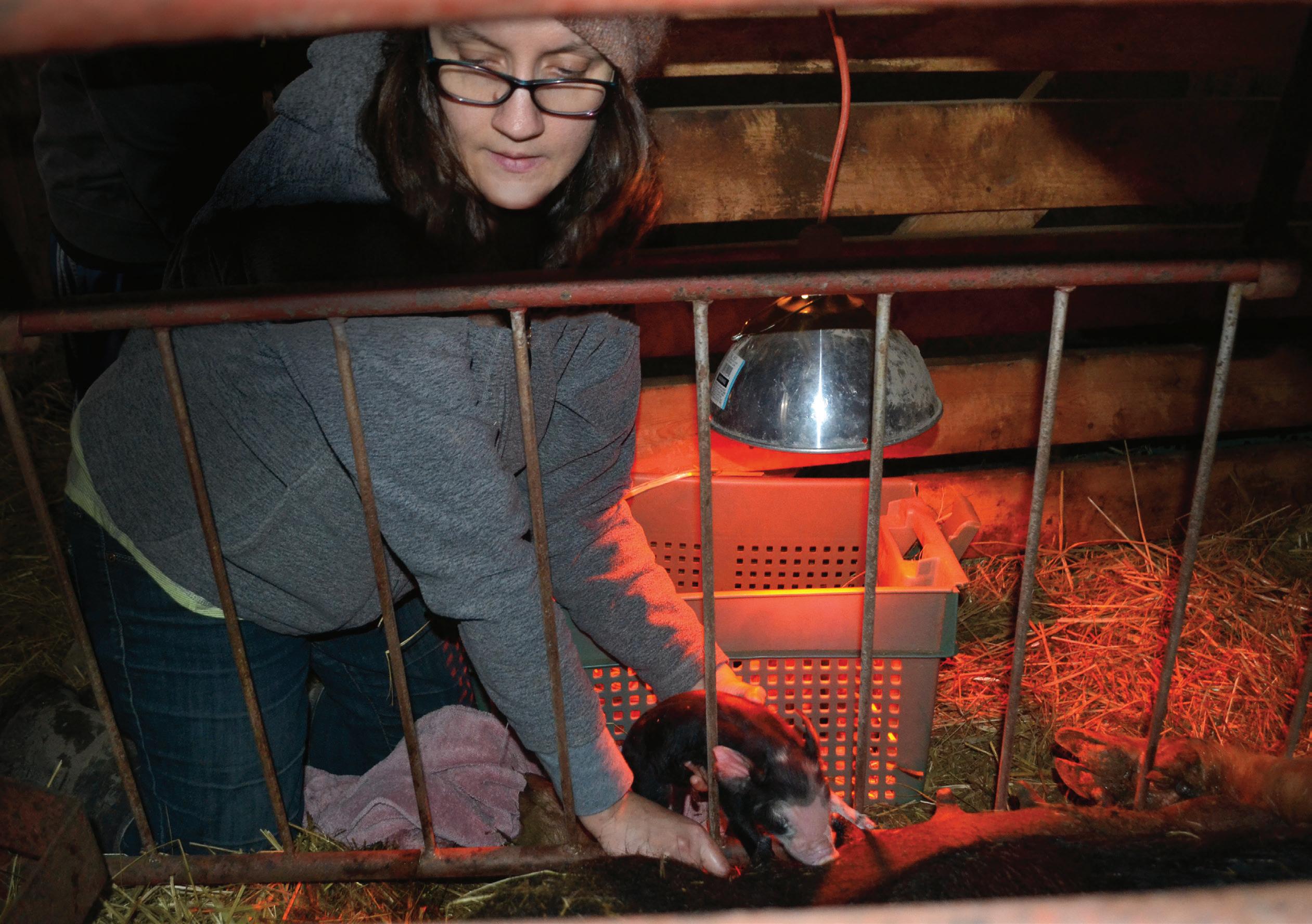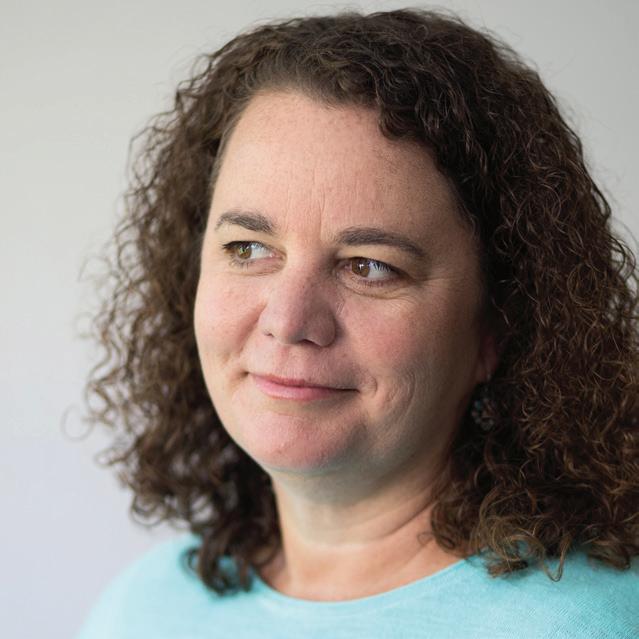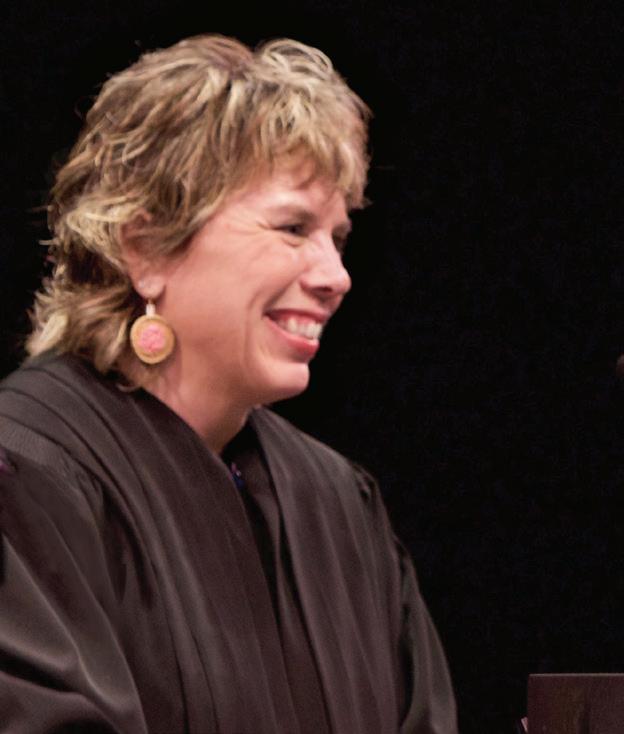
11 minute read
FROM THE PRESIDENT
A Letter from the President
I began my new role as president of our beloved St. Catherine on August 15. The welcomes from faculty, staff, students, alumnae and the Board of Trustees deeply touched me — most especially the campus signs that said “Welcome Home, Becky!”
Home is what St. Catherine has always felt to me, and it is deeply connected to the theme of this fall issue — food. Nothing connects us more to each other than where and with whom we feel at home, and how we share food. It is central to any notion of community.
I drafted this note on a Southwest plane returning from a weekend with my closest women friends from Harvard Business School. While our career lives have taken many different directions, the conversation often centered on mortality and recent losses that had been sustained by some in our circle, and what we wanted to do with the next 20–30 years of our lives if we were lucky enough to enjoy time and health.
I shared the story told at my sister’s funeral about a woman who loved carnivals. She learned one was coming to her town for one day so she saved her money so she could ride every ride. She was at the gates when they opened and immediately realized she had enough money to ride every ride but not enough time to ride every ride. She had more money coins than time coins. The point about my sister MaDonna (1981 grad) was that she had made great choices for how and with whom she spent her coins of time.
If you are reading this magazine, somewhere in your life you chose to invest both your coins of time and your coins of money in a St. Catherine education. I hope you are proud of the choice you made; I know St. Catherine is proud of you.
However many coins of time we each have left, let us enjoy them and spend them to be a positive force for good in the world.
Remember wherever you are in the world, St. Catherine is yours and you are always welcome here.
I close with a poem that was sent to me this week by Jill Underdahl, CSJ, ’92. I hope you love it as much as I do.
ReBecca Koenig Roloff ’ 76, MBA
Connections are made slowly, sometimes they grow underground. You cannot tell always by looking what is happening. More than half a tree is spread out in the soil under your feet. Penetrate quietly as the earthworm that blows no trumpet. Fight persistently as the creeper that brings down the tree. Spread like the squash plant that overruns the garden. Gnaw in the dark, and use the sun to make sugar.
Weave real connections, create real nodes, build real houses. Live a life you can endure: make love that is loving. Keep tangling and interweaving and taking more in, a thicket and bramble wilderness to the outside but to us interconnected with rabbit runs and burrows and lairs.
Live as if you liked yourself, and it may happen: reach out, keep reaching out, keep bringing in. This is how we are going to live for a long time: not always, for every gardener knows that after the digging, after the planting, after the long season of tending and growth, the harvest comes.
AN EXCERPT FROM A POEM BY MARGE PIERCY
Food for Thought

St. Kate’s students tackle global food issues in their quest to become ethical and socially responsible leaders.
BY PAULINE OO
FOOD. It nourishes our bodies. It brings family and friends together. It evokes memories of childhood, grandma’s kitchen or nostalgia for cultural ancestry. Yet at St. Kate’s, food plays an additional role. It is a guide that shines a light on a wide range of issues, including poverty, climate change and global health. No wonder academic departments across the University are infusing it into their curriculum.
In communication studies, there’s a course built around food justice movements and the use of public rhetoric to fight for equity and sustainability. In psychology, eating — and the many circumstances that positively and negatively influence the behavior — is the subject of a class. The nutrition and exercise sciences department now offers a syllabus focused on food systems, in response to growing demand in understanding how food moves from seed to grocer. The list goes on.
“Of all the topics we can talk about, food is one of the most accessible,” says social work professor Katharine Hill. “Everybody eats.”
In two classes, “Social Policy for Social Change” and “Food, Faith and Social Transformation,” which she co-teaches with a theology colleague, Hill challenges her students to shop for groceries using only the equivalent of the U.S. food stamp allowance. While many find it hard to fill up or stave off hunger on about $5 per person a day, Hill says her simple lesson in food access and poverty opens eyes.
“My students have to make some pretty tough choices, and they have to ask themselves what’s important and what they are willing to give up,” explains Hill. “This exercise gives them a glimpse of the decision-making process millions of low-income Americans grapple with each day. Food is a social justice issue because if people don’t have enough to eat, a lot of things don’t matter.”
BEYOND BROCCOLI
According to the United Nations World Food Programme, 795 million people — nearly 1 in 9 — go hungry. In fact, poor nutrition causes 50 percent of all child deaths in the developing world.
“We talk about food in all our core courses on some level because nutrition is tied to many health outcomes, such as obesity, cardiovascular disease and diabetes, and hunger is a global health issue,” says Mary Hearst, director of St. Kate’s public health program. “We also examine the social, political, economic and geographic factors that influence food security around the world, who has it and who doesn’t, and what we can do to change it.”

To help her students see the bigger picture, Hearst leads a class exercise using the Dietary Diversity Assessment, which measures a person’s nutritional intake by food groupings that represent key nutritional components. She uses this questionnaire internationally, too, when researching nutrition and growth of children in low-income settings. Students then compare their own results with that international data.
“The purpose of this exercise is to get them to think more broadly,” Hearst explains. “I want students to think less about the broccoli they ate yesterday and more about what’s going on in the world around them that allows for, or doesn’t allow for, proper nutrition.”
When she used the tool in Africa, Hearst found the average Zambian diet lacking. It only included one or two food groups — compared to the five a typical American eats. Her students wonder about the discrepancy.
“Because Zambians lack money, they live in a rural environment and they are dependent on whatever crops they can grow, which sometimes they need to sell and not eat,” she says. “When our students start to look at patterns and distribution across populations, that’s when they can begin to influence change.”
OF FISH OIL AND SMARTPHONES
Getting students fired up about sustainable food solutions and government regulations is a goal of Christina Meyer-Jax’s newest class, “Food Systems and Policy.” This course, created for St. Kate’s nutrition science major, evaluates the path that food travels from field to fork and how nutrition policies influence dietary recommendations and, ultimately, what’s on our plates.
“We’ve definitely increased the elements of social justice in our department because consumers today want to know where their food comes from and what’s in it,” says Meyer-Jax, a registered dietitian and assistant professor of nutrition.

In class, her students dive into a range of topics. They tackle complex issues such as the connection between overfishing and the American Heart Association’s call to increase omega-3 fatty acids intake. Since 2000, adults have been encouraged to eat more fish, especially oily species like mackerel, lake trout and salmon at least twice a week. However, according to the Food and Agriculture Organization of the United Nations, 70 percent of the world’s fish species are already extinct or endangered, and some fish populations have fallen as much as 95 percent in the past decade.
“Fatty fish consumption for omega-3s is a good recommendation for a myriad of health-related issues,” says Meyer-Jax, “but it’s not sustainable. We’ve already out-fished our planet. If everyone actually followed that guideline, there would be no way to ecologically support it.”
Another topic she explores with students is food labels and the legislation behind them. They discuss the federal bill recently signed by President Obama that allows food companies to use electronic quick response (QR) codes — instead of text on packaging — to indicate if their product contains genetically modified organisms. The
PROFESSOR MARY HEARST IS ONE OF SEVERAL ST. KATE’S FACULTY WHO CONNECTS FOOD AND SOCIAL JUSTICE ISSUES IN HER CLASSES. SHE TOOK THIS PHOTO OF A VEGETABLE GARDEN WHILE CONDUCTING RESEARCH IN ZAMBIA.
problem with QR, notes Meyer-Jax, is two-fold: most shoppers don’t regularly use it, and only smartphone owners can scan the code. She analyzes this disparity in food transparency from both a domestic and global level in her class.
“I knew coming to the University that I wanted to fight for access to healthy, affordable and culturally appropriate food,” says dietetics major Anne Janzen ’16. “I now have more context to do this. St. Kate’s really opened my eyes to the whole food system. It taught me that if I want change to happen, I have to understand the system. Without that understanding, I’m not going to get very far.”
COFFEE OR MOSQUITO NETS?
In this age of fair trade, all natural, organic, local, grass fed, cage free, humane certified and pasture raised, how can we keep our options straight and make the most ethical choices about the food we eat? Jeff Johnson, a St. Kate’s philosophy professor, says the answer begins with knowing ourselves. And he uses that maxim broadly in his classes.
“I encourage my students to think about what they value and to make decisions that best reflect those values,” he notes. Five years ago, Johnson brought the world of food into his syllabus because he “wanted to give them something to grapple with that directly relates to their everyday lives.”
When he talks about “effective altruism” — the concept that humans are called to try to do the most good they can to help others — he uses global food topics to drive home the idea.
“Let’s suppose that fair trade coffee is going to cost me $5 more than conventional coffee, but I buy it because my $5 could translate to an extra 13 cents a day for a worker,” Johnson explains. “With effective altruism, I would have to ask myself ‘is this the best decision I can make given the alternatives that I have?’ Do I spend that $5 supporting the fair trade worker or do I buy two mosquito nets that will protect three to four people from malaria for a few years?”
It’s a controversial view, he admits. And his students are “often perplexed by it.” Yet, he persists: “I want them to be aware and attentive to all the opportunities available, and I always remind them, ‘If you feel called to do the most good, you’ll sometimes find yourself making a choice that seems counterintuitive.’”
Together, they also ponder animal welfare and environmental issues related to food consumption. For example, consider buying tomatoes in Minnesota in January. Do you choose “locally grown” or “fresh from Florida”? Which is more environmentally sustainable? Could it take more energy to keep greenhouses warm in winter climates than the carbon emissions created by transporting produce from one end of the country to the other?
Or, consider buying chicken sourced through corporate farming or grass-fed beef from a local farmer. Which is more humane? Which produces fewer emissions?
According to a 2006 United Nations report, animal agriculture is responsible for 18 percent of our total carbon emissions, which is more than all forms of transportation combined. And while chicken farming is the least harmful to the climate of all meats, it’s also one of the least humane.
“If you don’t travel a lot by airplane, the most impact you can have on the environment is by changing your diet,” says Johnson, a vegan and the faculty advisor for St. Kate’s student club Advocating for Animals. “Plus, there’s a lot of research coming out about the emotional lives of animals, and that’s another reason compelling us to reconsider our eating practices and standards.”
So, food. Yes, it’s more than survival and a reason to get together. It makes us think. St. Kate’s is transforming students into global, reflective and compassionate leaders by encouraging them to look closely at the plate in front of them.








